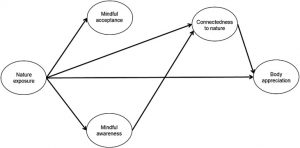Improve Body Image with Exposure to Nature and Mindfulness
By John M. de Castro, Ph.D.
“Exposure to natural environments may, therefore, offer a novel and cost-effective means of promoting healthier body image,” – Viren Swami
The media is constantly presenting idealized images of what we should look like. These are unrealistic and unattainable for the vast majority of people. But it results in most everyone being unhappy with their body. This can lead to problematic consequences. In a number of eating disorders there’s a distorted body image. This can and does drive unhealthy behaviors. As a treatment mindfulness has been shown to improve eating disorders.
People have long reported that walking in nature elevates their mood. But it has also been reported that exposure to nature improves body image. Recently it has been shown that mindfulness training in the natural environment, especially in wild environments, produces greater benefits than similar training in non-natural settings. This suggests that mindfulness and exposure to nature may interact and supplement one another producing greater benefits. But there is little systematic research regarding the effects of exposure to nature and mindfulness on body image.
In today’s Research News article “Nature exposure and positive body image: (Re-)examining the mediating roles of connectedness to nature and trait mindfulness.” (See summary below or view the full text of the study at: https://www.ncbi.nlm.nih.gov/pmc/articles/PMC7320863/) Swami and colleagues recruited healthy adults over the internet and had them complete measures of body appreciation, exposure to nature, connectedness to nature, mindful awareness and mindful acceptance.
They found that all variables were positively related to all other variables. For example, the higher the levels of mindful awareness the higher the levels of body appreciation, exposure to nature, connectedness to nature, and mindful acceptance. Path analysis revealed that exposure to nature was positively related to body appreciation directly and also indirectly by being positively related to connectedness to nature which in turn was related to body appreciation. Exposure to nature was positively related to connectedness to nature directly and also indirectly by being positively related to mindful awareness which in turn was related to connectedness to nature.
This study was correlational and as such causation cannot be determined. Nevertheless, the study demonstrated that higher levels of exposure to nature are associated with higher levels of appreciation of one’s body. They also demonstrate that this association is both direct and indirect via mindful awareness and connectedness to nature. The direct connection has been previously demonstrated. The indirect paths, on the other hand are new.
The results suggest that getting out into natural settings is associated with an improved body image. It is possible that nature contains a wide variety of different shapes and sizes of all of its elements and this makes one more accepting of the naturally occurring differences in human shapes and sizes. The fact that exposure to nature also is related to higher levels of mindful awareness supports this contention. Mindfulness awareness involves seeing things just as they are without judgement including the body and this appears to be related to exposure to nature.
Getting out into nature has been shown to have widespread benefits for the psychological health and well-being of humans. The present study suggests that an additional benefit is to promote an acceptance and appreciation of one’s own body. Although not studied here, this suggests that getting out into nature may help prevent eating disorders that are often connected to a distorted image of the body.
So, improve body image with exposure to nature and mindfulness.
“An environment that does not require undivided attention may provide people with cognitive quiet, which in turn may foster self-compassion such as respecting your body and appreciating it is part of a wider ecosystem requiring protection and care.” – Science Daily
CMCS – Center for Mindfulness and Contemplative Studies
This and other Contemplative Studies posts are also available on Google+ https://plus.google.com/106784388191201299496/posts and on Twitter @MindfulResearch
Study Summary
Swami, V., Barron, D., Todd, J., Horne, G., & Furnham, A. (2020). Nature exposure and positive body image: (Re-)examining the mediating roles of connectedness to nature and trait mindfulness. Body image, 34, 201–208. Advance online publication. https://doi.org/10.1016/j.bodyim.2020.06.004
Abstract
Previous studies have reported a significant association between nature exposure and positive body image, but understandings of the mechanisms that help to explain this link remain nascent. Here, we considered the extent to which trait mindfulness and connectedness to nature, respectively, mediate the aforementioned relationship both in parallel and serially. An online sample of 398 participants (199 women, 196 men, 3 other; age M = 28.1 years) from the United Kingdom completed measures of self-reported nature exposure, mindful awareness and acceptance, connectedness to nature, and body appreciation. Results indicated that inter-correlations between scores on all measures were significant and positive. Following the elimination of non-significant pathways, path analysis resulted in an adequately-fitting model in which the direct relationship between nature exposure and body appreciation was significant. In addition, connectedness to nature – but not trait mindfulness – significantly mediated the direct relationship. Finally, we also found evidence of a serial mediation, where the association between nature exposure and body appreciation was mediated by mindful awareness followed by connectedness to nature. The implications of these results for scholarly and practitioner understanding of the impact of nature exposure on positive body image are discussed in conclusion.
https://www.ncbi.nlm.nih.gov/pmc/articles/PMC7320863/
